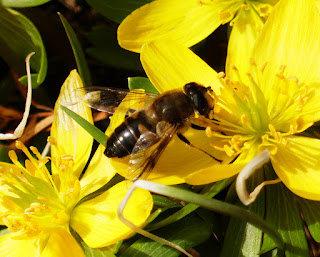Common Drone Fly
Here's a Common Drone Fly. As the most widespread syrphid in the world -and- as a bee mimic, it's been suggested that they've been misidentified in photographs as bees more than any other species. And they are very widespread, being pretty much everywhere with the (not uncommon) exception of Antarctica [1] [2].
The males are very territorial, and not just against rival males of their species. They apparently dart after and attempt to chase away bees, wasps, butterflies, and (presumably) other types of flies. Since they can't sting and they're a lot smaller than many butterflies, it's unclear they'd win a fight against any of these guys [3]. Perhaps it's a bluff that frequently works because the other insects don't want to risk a fight against a foe they don't understand?
It sounds like defending their territory is so ingrained in them that when they need a break from all that darting around, they actually leave their own territory for some R&R. I assume that if they're able to clear an area of everything else, the area probably is a wide open and appealing area for Common Drone Fly females.
What makes a good territory? Besides having food sources (mostly nectar-producing flowers), it's beneficial for the territory to be higher than the surrounding area since Common Drone Flies engage in hill-topping. This is the practice where insects congregate at/near the top of a hill when looking for a mate. Elevation above sea level isn't important, just that the spot is locally higher than the surroundings. For good or ill, many other insects engage in hill-topping [4].
Here's a short video of a Common Drone Fly. Though I don't think they make a classic "bee buzz", they do make a somewhat similar sound.
 |
| March 2, 2020 at the Willowwood Arboretum Photo 68940310, (c) jpviolette, some rights reserved (CC BY-NC) |
[1] Being an isolated continent with extreme cold temperatures and very little vegetation combine to make it the exception when discussing most "worldwide" flora and fauna.
[2] Though they're all over North America, they're not native to the continent. Presumably they arrived as stowaways, then escaped to the wild.
[3] I don't know what happens if they spot a predatory insect like dragonflies, damselflies, or robber flies, all of whom would happily eat a Common Drone Fly. The CDF does look like a bee, so perhaps concerns about getting stung might drive them away.
[4] Note to self: Maybe I should check out hilltops more often when looking for bug pics.



Comments
Post a Comment